Named after Alan Freed, the original Rock and Roll DJ and dedicated mostly to music & radio. See also my Classic Film & TV blog @ http://thesilverscreenchronicles.blogspot.ca/ For My CIUT 89.5fm in Toronto radio playlists; http://moondogsplaylists.blogspot.com/

Thursday 11 April 2024
The Real Outlaw Country
BEYONCE' ~ "JOLENE";
I have no interest in Beyoncé, and don't care about her C&W album but I have been fun to watch for those fragile white dudes offended about a black R&B artist doing country like this has never happened before. Besides the usual professional trolls at FOX like Greg Gutfield who has done multiple segments referring to it as "cultural appropriation" (seriously, stop giving Republicans dictionaries) this week has seen the unasked for return of a washed up eighties Country singer John Schneider who not satisfied with the usual angry washed up white guy bleating has kicked off a boycott. Also not satisfied with boycotting the album itself (which OK, fine, don't buy it) he's inspired his own pitchfork wielding mob to barrage Country radio stations with demands to cancel Beyonce. This sort of hicktovism was successful back in the 2000's in cancelling the Dixie Chicks who had been genuine Country stars. Country radio is incredibly conformist and a bare handful of white guys actually do have the power to ban literally any artist at the drop of a hat, they also buried Faith Hill's pop crossover album in the 2010's. However, whether they could actually be bothered to take the time to ban an album they aren't planning to give much airtime to anyway is another matter.
CHARLEY PRIDE ~ "KISS AN ANGEL THIS MORNING";
As for John Schnieder, while he is being billed in news reports as a "Country singer" he actually owes his (past due) fame to being one of the dudes in the eighties from "Dukes Of Hazzard" who raced around in a car named after Robert E Lee decorated with a Rebel Flag. That show was a huge hit and piggie-backing off of that he made a play at being a Country singer and it's true that he even scored a few hits. However at the time most actual Country artists and critics dismissed him as a pretty-boy poser coasting on his TV fame kind of like a Nashville Frankie Avalon or Fabian. Assuming Frankie Avalon or Fabian were Confederate apologists. And assholes. So the next time the dumber Duke Boy whines that Beyonce, who is an actual singer, hasn't paid her dues he should sit this one out. You may remember that General Lee car that had a horn that blared "Dixie"? That car was literally more musically relevant than John Schneider.
Setting aside the usual silliness it's been fascinating to watch mediocre white dudes gnashing their teeth and rending their garments over the insult of a Black R&B star disrespecting sacred Country music. No less a figure than Dolly Parton herself has proclaimed herself a fan of Beyonce's cover as has Willie Nelson and Carlene Carter, a member of Country royalty as a member of the Carter Family and step-daughter of Johnny Cash. Maybe, just maybe they know more about Country music than John Schneider let alone Greg Gutfield or Steven Crowder. Maybe they also know more about the history of black Blues and R&B artists recording Country music.
People have rightly pointed out that Charley Pride had a long successful career as a Country singer but Pride was always a Country singer from the start and never recorded any Blues or R&B. He probably could have done so but was always concerned about maintaining his hard won credibility with his white Country audience so he never did. But you know what black Blues, Jazz or R&B artists went Country?
RAY CHARLES ~ "I'M MOVING ON";
Ray Charles, The Supremes, Bobby Womack, Louis Armstrong, Andre Williams & rural Blues singer Scott Dunbar did entire albums of Country songs. Ray Charles actually did more than one. Whitney Houston's biggest hit was a Dolly Parton cover (which Dolly loved). The Pointer Sisters had a song ("Fairy Tale"), which actually won a Country Grammy in 1974. Singer/guitarist Chris Thomas King appeared in the film “Oh Brother Where Art Thou” (2001) and played on the Grammy winning soundtrack. Blues singer Pink Anderson had previously recorded "In The Jailhouse Now" (1961) one of the songs on that soundtrack. Hootie & the Blowfish frontman Darius Rucker has had a successful career. Charlie Parker admired Hank Williams songwriting, Chuck Berry admired Country pickers like Merle Travis, Sugarfoot Garland & Arthur Smith. Howlin' Wolf was a big Jimmy Rodgers fan and said his trademark howlin' moan was inspired by Rodger's famous yodel. Louis Armstrong even played on a few Rodgers singles. Singer and pianist Big Al Dowling played on several Wanda Jackson songs (I interviewed her once and she mentioned him with affection), the late Blues singer John Jackson told me he grew up on Jimmy Rodgers & Uncle Dave Macon records ("All us Black folks loved them"), Ice-T once told me he liked Johnny Cash ("He once shot a man in Reno just to watch him die, that's Gangsta"), Cash was also super popular in Jamaica where he had a vacation house. As an odd historical note during Reagan's invasion of Grenada the US Army's psychological warfare unit set up a Radio Free Grenada and showed up with a stack of Reggae, Ska and Calypso records only to be amazed to get calls requesting Johnny Cash songs. In the 1930's Folklorist John Lomax made field recordings in the Bahamas including a string band doing an early version of the classic Murder Ballad "Delia's Gone" that had been recorded by several singers and would later be recorded by Johnny Cash among others.
THE NASSAU STRING BAND ~ "DELIA'S GONE";
Records made in the 1920's and 40's in Africa by such guitarists as the Kumasi Trio (from Nigeria), Jean Kalafayi (Congo), Midian Ncube (Zimbabwe) and John Bhengu (South Africa) showing the influences of American Country and Blues records that had been circulating in Africa since the 20's. Jim Reeves and Slim Whitman were very popular in South Africa, mostly with whites but they were familiar to black listeners as well. Leadbelly recorded cowboy songs including the classic "Old Chisholm Trail" originally recorded by Harry McClintock. The Pointer Sisters once played the Grand Ole Opry and so did James Brown, James Freaking Brown. They weren't even the first as early as the 20’s Black harmonica player DeFord Bailey was a regular at the Opry and toured with Uncle Dave Macon.
THE POINTER SISTERS ~ "FAIRY TALE";
None of this should really come as a surprise. Most of these artists were themselves Southerners raised on radio at a time when there were few if any radio stations catering to black listeners outside of a few cities like New Orleans and Memphis and Country radio was the only game in town. Beyond that, serious musicians and music nerds love hearing new things and are never afraid or offended by music from other cultures even if they don't end up as fans. If you can't handle that then you don't actually like music or art at all. You certainly don't deserve it. So how about you leave it to those who do and you just stay in your lane, banning books.
PINK ANDERSON ~ "IN THE JAILHOUSE NOW";
Monday 12 February 2024
Upcoming 2024 Shows; Feb.17!
Celebrate or work out your Post Valentines Blues with the Surf & Turf Sounds Of Canada's Oroginal Surf Punks, Mark Malibu & The Wasagas vs Toronto's newest Girl Garage Gang The Kewpie Dolls plus the mysterious Surf Garage sounds of Vox Confidential. At the Dakota 242 Ossington, doors at 10.
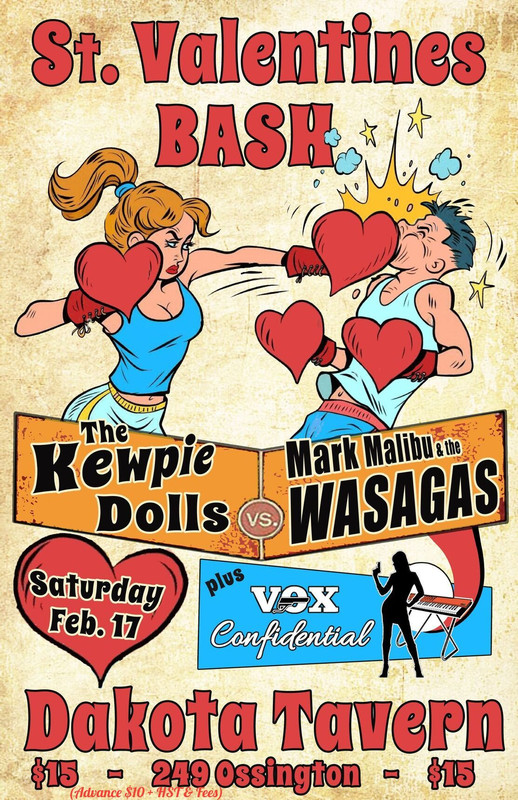
MARK MALIBU & THE WASAGAS ~ "ASTROBOT";
MARK MALIBU & THE WASAGAS ~ "PET CEMETERY";
MARK MALIBU & THE WASAGAS ~ "SEVEN YEAR SURF ITCH";
THE KEWPIE DOLLS;
Labels:
Garage,
Kewpie Dolls,
Surf,
Wasagas
Tuesday 23 January 2024
Professor's Kitzell's Time Machine; In Search Of The Weems String Band

The first generation of recording artists of Jazz, Blues, Gospel and Country music recorded during the 1920's are vitally important to the evolution of their modern descendents as well as their more unruly Rock & Roll cousins but at the same time they can seem as far removed and lost in time as the Dead Sea Scrolls. As dusty and cobweb encrusted as a forgotten box of 78's themselves. Part of this is just the sound of the records themselves, some with as much scratch, pop and hiss as the broadcast from the Apollo 11 astronauts. Then there's the way 78's actually feel in your hand, heavy but fragile. Mostly there's the fact that for some of these artists are complete enigmas about whom virtually nothing is known, even some important names. Blind Blake, one of the most important of the early Blues guitarists, is still almost a total mystery.
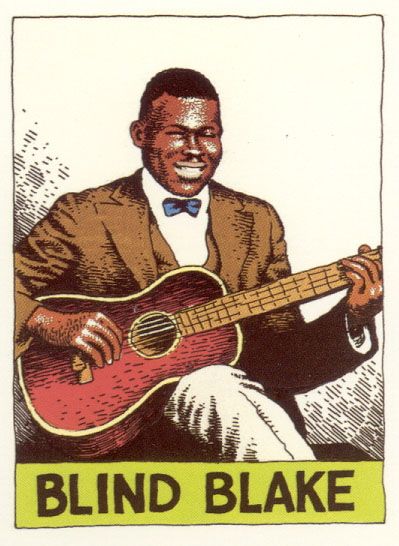
Blake was one of the most important early Blues guitarists and yet he is ghostly figure with only one known photo and the official bio from Paramount Records claiming he was from Jacksonville, Florida while modern researchers have claiming his accent suggests the Sea Islands off the Atlantic Coasts of Florida, Georgia and South Carolina while another scholar found what appears to be his death certificate claiming his birthplace as Virginia. His reported death around 1934 is a mystery as well with contemporary Rev Gary Davis claiming he had been killed by a streetcar while Big Bill Broonzy reported he had died in the streets of Chicago in a winter snowstorm having had a heart attack brought on by obesity and dying of exposure. The latter seems at odds with the known photograph which shows Blake as not being fat at all and it's more likely Broonzy confused Blind Blake with Blind Lemon Jefferson who reportedly did die in pretty much that fashion in 1929 and who actually was fat. That's where things stood until modern researchers unearthed his death certificate reporting he died rather more prosaically of pneumonia and tuberculosis in Glendale, Wisconsin, not far from Paramount Records, in 1934. Then there's Gospel singer Washington Phllips, who recorded several singles of such a uniquely ethereal quality that to this day scholars fight over what instrument he even played. The only grainy photo of him clearly shows him holding two zithers in a promo pic but for decades most scholars have insisted that actually played the Dolceola, an obscure small keyed instrument. His birth remains unknown but for many years it was reported that he had died in an insane asylum in 1938 until modern research turned up records of him dying in 1954 of injuries after a fall.
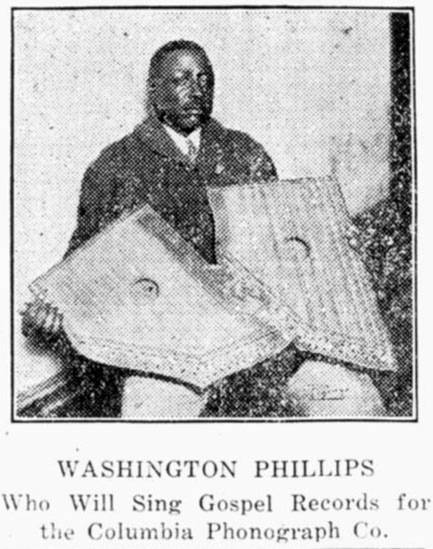
If some black Blues and Gospel artists are mysteries, many white Old Time Country artists are equally so. One such obscurity is the Weems String Band, who have fascinated scholars and folklorists even though they only recorded one known single in 1928. That single was a version of the well known tune "Greenback Dollar" backed with a likely improvised original "Davy" which basically sounds like the same song albeit with lyics which might be offensive if we fully could make them out. Not on the surface a promising selection but Old Time fiddle nerds have fixated on the unique playing style of the two fiddle players who used fingering positions normally used by classical violinists backed with a bowed cello suggesting some formal training but combined with a clanging banjo and yelping vocals calling out a repetitive chorus resulting in a sound that sounds both crude and driving yet delicate and restrained. After recording their one recording session they disappeared for years. Meanwhile as the Weems String Band receded into the mists of the Appalachia Mountains for decades their one odd single attracted the attention of devoted fans of Old Time Country and record collectors including the artist R Crumb who used the then only known photo of the band for an illustration on one of his collection of "Pioneers Of Old Time Country Music" trading cards in the 80's. The information then given told little more than the names of four of the members and that they hailed from Perry County, Tennessee, with the band including brothers Dick and Frank Weems on fiddles, brother Jesse on bowed cello and cousin Alvin Conder on banjo and vocals with two unknown younger members on guitar and banjo. And for another twenty years that's where things sat.
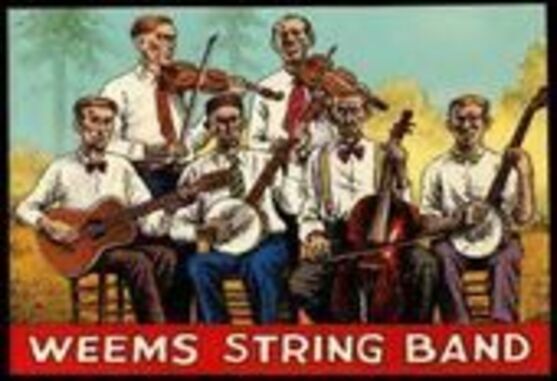
R CRUMB ILLUSTRATION
In 2000 brought the news that the photo that was used as the basis for the Crumb illustration with the two younger players on either side who had not actually been on the recording session. When Crumb was informed of this he updated the drawing to remove the two younger players in an illustration published in the "New Yorker" magazine in 2001. The internet age allowed for more amateur sleuthing starting with a posting on the website Banjo Hangout in 2008 asking for info on the band and it turned out there were actual folks from Perry County who dropped in including a claimed descendant who reported that the other two members shown on the card were Atlas "Dodge" Conder and Ray "Doc" Hinson who was Dick Weems' stepson the latter of whom was as of 2008 still alive and so could fill out more missing pieces.
THE WEEMS STRING BAND ~ "GREENBACK DOLLAR";
The version of the Weems Stringband that made their only single was indeed a four piece of the three Weems Brothers and Conder who piled into their Model T Ford and travelled to Memphis to do a recording session for Columbia records in 1927. They had apparently planned on recording a few instrumental fiddle jams which was their prefered genre and common fare in rural county fair hoedowns which could go on for hours. However once they got to the studio the producer turned them away saying they were not interested in instrumentals which did not sell very well and if the band wanted to record (and get paid) they had better come back with some proper songs. Therefore the Weems boys and Conder trudged back to their hotel room and pieced together a version of the basic lyrics to the standard "Greenback Dollar" and another tune, did the session, collected their $100 fee and went home. The fairly structure-free, repetative nature of the two songs suggests these songs could have indeed gone on for several more minutes in a hoedown as do the fragmentary and largly incomprehensible lyics which basically consist of the chorus called out periodically to keep things moving.
The resulting record was released the next year which given how fast record companies worked back then suggests it wasn't exactly a top priority and while it wasn't a hit but seems to have done well enough that Columbia Records made an attempt to lure the Weems boys back for another session. However record keeping in 1928 was fairly lax and Columbia apparently lost track of the band and reportedly thought they were from Arkansas and after a half-hearted attempt to contact them gave up. Given that 1929 brought the stock market crash and the Great Depression which led to a steep decline in the recordings of both Blues and Country artists they probably didn't search too hard.
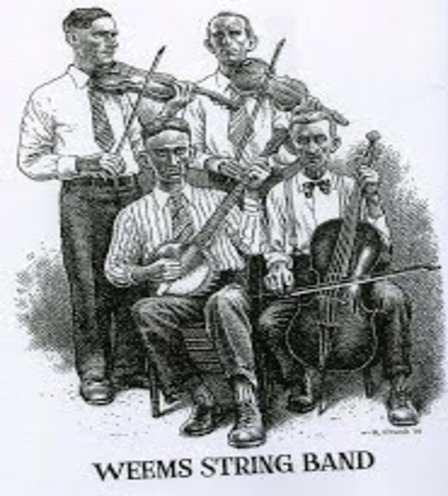
UPDATED ILLUSTRATION
After that the Weems boys continued on playing locally for many years eventually adding the younger Atlas "Dodge" Conder and Ray "Doc" Hinson to the band. Hinson was not born until 1933 so the existing photo of the band which includes him apparently in his teens must have been taken sometime in the forties over a decade after the recording session. Alvin Conder reportedly played at the Grand Ole Opry in some capacity although there is no record of the Weems String Band playing there so he must have played backing up another singer or band.
The Weems boys got their musical background from their father WT Weems who ran the local general store and post office in the village of Mouse Landing which sounds like the sort of place Frodo Baggins would do his shopping. However besides the store WT was also known as an expert fiddler and he passed that on to his sons which begs the question that has puzzled Old Time Fiddle conisures, namely did he teach the boys their unique classically inspired fiddle style and if so where did he pick it up? That is still a question unanswered and likely to remain so.
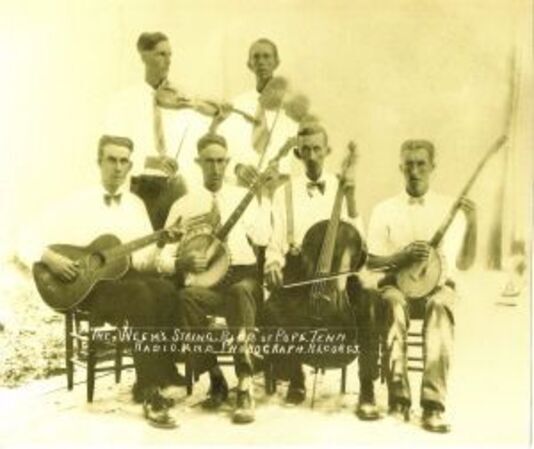
ORIGINAL PHOTO
In 2008 Ray Hinson was described as "getting up in years" but still happy to talk about the old days of the Weems band and it's a pity that no researcher bothered to make the trek to Perry County and interview him as he was likely the last surviving member of Old Time Country and Blues musicians immortalized by R Crumb and a last link with the early days of C&W music. The only partial updating of the record was a 2013 short video doc made by the Arts Center Of Cannon County which also includes some info on patriarch WT Weems and a few more photos. (although be aware that some of the photos used appear to be random and may not have any actual connection with the Weems Band, the video doesn't specify)
"THE WEEMS STRING BAND" (2013 doc);
Speaking of amateur sleuthing on a whim I decided to do some of my own and discovered the graves of some of the Weems band along with a few other details. In fact the Weems clan were locally prominent enough to have their own cemetery which I found a record of here; https://www.tngenweb.org/records/perry/cemeteries/weems
And another here; http://files.usgwarchives.net/tn/perry/cemeteries/weemscem47gcm.txt
Weems Cemetery is on State Highway Spring Creek area of Perry County being described as well maintained and having over sixty headstones along with possibly several dozen unmarked graves. The gravestones date back as far as the 1890's although there are a couple from the 1860's and the graveyard was still being used sporadically as of 2001. The Weems name shows up twenty seven times and includes bandleader Dick Weems who is shown as having been born in 1888 making him 40 at the time of the recording and dying in 1965 aged 77. There is a Frankie Weems having died in 1933 with no birth date given however as we now know that famous photo which must have been taken in the late forties at the earliest as it includes Ray Hinson who was born in 1933 then this can not be the Frankie we are looking for. However some more searching led to another graveyard at the Howard Methodist United Church north of HWY 412 at the mouth of Cypress Creek. This site can be seen here; https://www.tngenweb.org/records/perry/cemeteries/howard.htm
THE WEEMS STRING BAND ~ "DAVY";
This cemetery is smaller, having about eighty marked graves and an unknown number of unmarked graves. It is not as well tended. Among the marked graves are three more Weems headstones including another Frankie Weems listed as being born on September 20 1879 and dying September 10 1967 which certainly fits with our timeline. Neither cemetery has any stones for Jesse Weems or Alvin Conder so they must have been buried somewhere else unless they are among the unmarked graves mentioned here. We can probably safely assume they're not still around. While Alvin isn't here the Conders (who were referred to as cousins to the Weems) are well represented with seven graves although all but one of these predate the twenties suggesting they moved away at some point. Ray Hinson's mother Virginia is also here, born in 1907 and dying in 1976. The Howard Church does not have any Conder or Hinson graves listed. However remembering that that one of the younger band members who joined later was named Atlas Conder there is a Joseph Atlas Beasley listed (1902-1917) and as Atlas is not exactly a common name and many of these people were clearly related (there are another fourteen Beasleys listed here while back at the Weems cemetery there is another grave which includes three names) he could be yet another cousin who the younger Atlas was named after. Atlas himself became a successful car dealer running the local Dodge dealership which is presumably where he got his name. Back at the Perry Cemetery we do also have a grave for patriarch WT Weems who was born on October 18 1849 and died February 20 1917 aged 68, unfortunately several years too soon to have been recorded himself so whatever fiddle secrets he had he took to the grave.
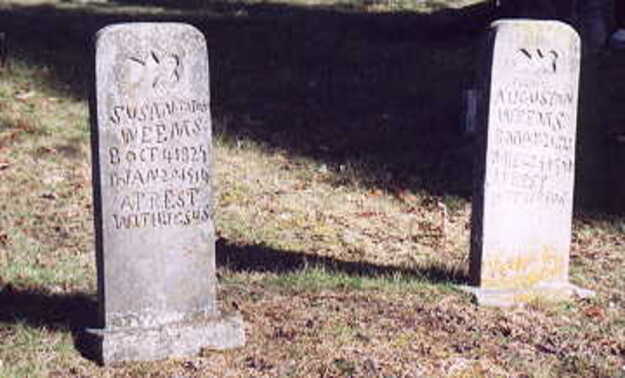
WEEMS CEMETERY
As for Ray Hinson I quickly discovered he only died in 2021 aged 88 still living in Perry County. His obit mentions that the Weems String Band kept going at least into the fifties although not as a recording act. After retiring from the music business he ran a housing construction company until he retired in the 1990's, he was also heavily involved in the civic society of Perry County being elected to the school board and church committees for which he also sing in their choir until just before his death. He was described as a great story teller which makes it a shame that nobody thought to interview him as possibly the last surviving link with the pre WW2 era of Old Time Country and rural music as well asthe last suviving subject of R Crumb's iconic trading card collection.
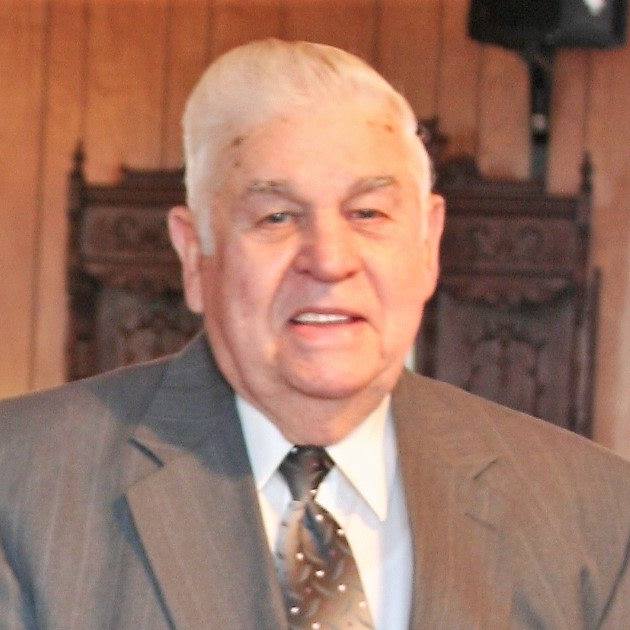
RAY "DOC" HINSON
Labels:
Old Time Country,
R Crumb,
Weems String Band
Subscribe to:
Posts (Atom)